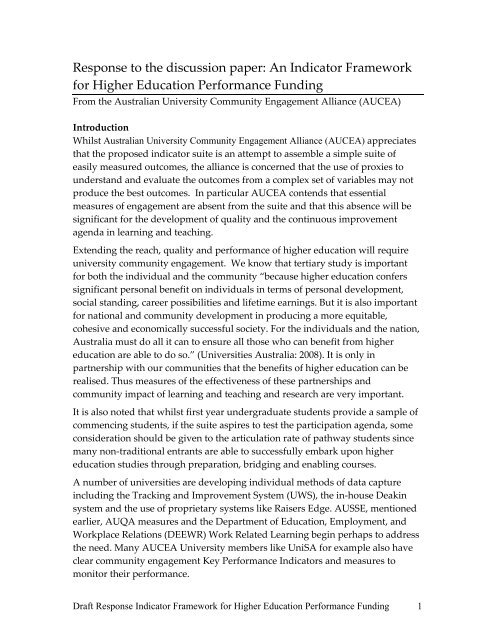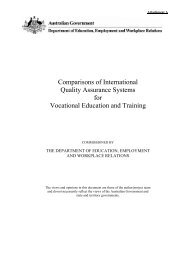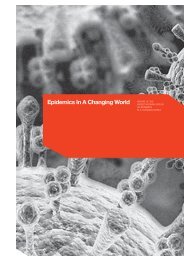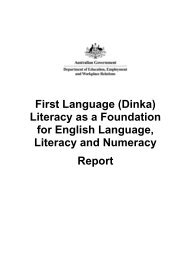aucea - Department of Innovation, Industry, Science and Research
aucea - Department of Innovation, Industry, Science and Research
aucea - Department of Innovation, Industry, Science and Research
You also want an ePaper? Increase the reach of your titles
YUMPU automatically turns print PDFs into web optimized ePapers that Google loves.
Response to the discussion paper: An Indicator Framework<br />
for Higher Education Performance Funding<br />
From the Australian University Community Engagement Alliance (AUCEA)<br />
Introduction<br />
Whilst Australian University Community Engagement Alliance (AUCEA) appreciates<br />
that the proposed indicator suite is an attempt to assemble a simple suite <strong>of</strong><br />
easily measured outcomes, the alliance is concerned that the use <strong>of</strong> proxies to<br />
underst<strong>and</strong> <strong>and</strong> evaluate the outcomes from a complex set <strong>of</strong> variables may not<br />
produce the best outcomes. In particular AUCEA contends that essential<br />
measures <strong>of</strong> engagement are absent from the suite <strong>and</strong> that this absence will be<br />
significant for the development <strong>of</strong> quality <strong>and</strong> the continuous improvement<br />
agenda in learning <strong>and</strong> teaching.<br />
Extending the reach, quality <strong>and</strong> performance <strong>of</strong> higher education will require<br />
university community engagement. We know that tertiary study is important<br />
for both the individual <strong>and</strong> the community “because higher education confers<br />
significant personal benefit on individuals in terms <strong>of</strong> personal development,<br />
social st<strong>and</strong>ing, career possibilities <strong>and</strong> lifetime earnings. But it is also important<br />
for national <strong>and</strong> community development in producing a more equitable,<br />
cohesive <strong>and</strong> economically successful society. For the individuals <strong>and</strong> the nation,<br />
Australia must do all it can to ensure all those who can benefit from higher<br />
education are able to do so.” (Universities Australia: 2008). It is only in<br />
partnership with our communities that the benefits <strong>of</strong> higher education can be<br />
realised. Thus measures <strong>of</strong> the effectiveness <strong>of</strong> these partnerships <strong>and</strong><br />
community impact <strong>of</strong> learning <strong>and</strong> teaching <strong>and</strong> research are very important.<br />
It is also noted that whilst first year undergraduate students provide a sample <strong>of</strong><br />
commencing students, if the suite aspires to test the participation agenda, some<br />
consideration should be given to the articulation rate <strong>of</strong> pathway students since<br />
many non‐traditional entrants are able to successfully embark upon higher<br />
education studies through preparation, bridging <strong>and</strong> enabling courses.<br />
A number <strong>of</strong> universities are developing individual methods <strong>of</strong> data capture<br />
including the Tracking <strong>and</strong> Improvement System (UWS), the in‐house Deakin<br />
system <strong>and</strong> the use <strong>of</strong> proprietary systems like Raisers Edge. AUSSE, mentioned<br />
earlier, AUQA measures <strong>and</strong> the <strong>Department</strong> <strong>of</strong> Education, Employment, <strong>and</strong><br />
Workplace Relations (DEEWR) Work Related Learning begin perhaps to address<br />
the need. Many AUCEA University members like UniSA for example also have<br />
clear community engagement Key Performance Indicators <strong>and</strong> measures to<br />
monitor their performance.<br />
Draft Response Indicator Framework for Higher Education Performance Funding 1
This work has developed alongside discussion focused on indicators <strong>and</strong><br />
benchmarks since AUCEA was first conceived as a national alliance in 2002. In<br />
2005 the AUCEA identified a need to encourage the development <strong>of</strong> national <strong>and</strong><br />
international benchmarks for engagement activity, the inclusion <strong>of</strong> engagement<br />
as a part <strong>of</strong> institutional pr<strong>of</strong>ile assessments by government <strong>and</strong> as part <strong>of</strong> the<br />
AUQA assessment regime. The early work in establishing the <strong>Research</strong> Quality<br />
Framework provided the impetus for seeking to underst<strong>and</strong> impact <strong>and</strong><br />
increasingly, universities, like many institutions, were driven by the need for<br />
accountability <strong>and</strong> an evidence base. Now the focus must be on an evidence base<br />
that will support Higher Education Compacts, the role <strong>of</strong> Higher Education<br />
Institutions in the social inclusion agenda <strong>and</strong> allow for measuring performance<br />
(Langworthy, 2009).<br />
The Discussion Paper asserts that the context for the proposed indicator<br />
framework is the Government’s desire to extend the reach <strong>and</strong> enhance the<br />
quality <strong>and</strong> performance <strong>of</strong> Australia’s Higher Education system through a range<br />
<strong>of</strong> measures including the introduction <strong>of</strong> higher education performance funding<br />
for teaching <strong>and</strong> learning. The objective <strong>of</strong> this performance funding “is to ensure<br />
that universities are contributing in negotiated ways to the national attainment<br />
<strong>and</strong> participation ambitions <strong>and</strong> enhancing the quality <strong>of</strong> their teaching <strong>and</strong><br />
learning by working towards institution‐level performance targets”. The paper<br />
also outlines principles underpinning the choice <strong>of</strong> indicators not unlike the<br />
principles developed for the AUCEA Community Engagement Framework <strong>and</strong><br />
Benchmarking Pilot Project, three <strong>of</strong> the most important being “be relevant <strong>and</strong><br />
measure what they purport to measure”; “inform <strong>and</strong> encourage policy <strong>and</strong><br />
practice at both the national <strong>and</strong> institutional level without having a perverse<br />
influence on behaviour”; <strong>and</strong> “accommodate <strong>and</strong> to the extent possible, facilitate<br />
institutional diversity”.<br />
AUCEA would contend that the proposed measures do not meet those<br />
underpinning principles in regard to community engagement. Further, because it<br />
is what we measure that matters in practice (as opposed to measuring what<br />
matters), these measures could also be counter‐productive to the development<br />
<strong>and</strong> valuing <strong>of</strong> good engagement. The AUCEA Benchmarking Pilot Project,<br />
which involved 14 Australian Universities, demonstrated that data were not<br />
captured in any systematic way within universities <strong>and</strong> that because there was<br />
no reporting requirement, there are no data across the sector relating to<br />
community engagement.<br />
Community engagement <strong>and</strong> learning <strong>and</strong> teaching<br />
Draft Response Indicator Framework for Higher Education Performance Funding 2
The first AUCEA Community Engagement position paper (2006) described<br />
engaged teaching, learning <strong>and</strong> the student experience:<br />
“Teaching <strong>and</strong> learning are traditional core business <strong>of</strong> universities. Engaged teaching <strong>and</strong><br />
learning speaks to community labour market needs as well as the need for students<br />
themselves to become knowledgeable <strong>and</strong> active citizens <strong>of</strong> their region, their nation <strong>and</strong><br />
the globalised world.<br />
Student learning as part <strong>of</strong> an engaged teaching program will ensure graduate<br />
employability <strong>and</strong> also exposes industry <strong>and</strong> the pr<strong>of</strong>essions to leading edge<br />
developments. Work integrated learning, internships, international experiences <strong>and</strong><br />
exposure to curricula that are informed by real world problems <strong>and</strong> solutions promises<br />
many benefits for students <strong>and</strong> for their communities. Students’ experiences <strong>of</strong> university<br />
are shaped by factors others than their study program. Many universities <strong>of</strong>fer extra- or cocurricular<br />
activities that provide opportunities for students to develop personally as well as<br />
pr<strong>of</strong>essionally. These are important <strong>and</strong> enriching activities that universities seek to<br />
sponsor within their resource constraints.”<br />
It is noted that the Australasian Survey <strong>of</strong> Student Engagement, the AUSSE<br />
survey, provides data on students’ involvement with key learning processes<br />
including active learning <strong>and</strong> work integrated learning; perceptions <strong>of</strong><br />
institutional supports; proxy learning <strong>and</strong> development outcomes; <strong>and</strong> intrinsic<br />
involvement with study. This survey is demonstrating the connection between<br />
engaged teaching <strong>and</strong> learning <strong>and</strong> student satisfaction (AUSSE 2008).<br />
Measuring Community Engagement<br />
Since 2005, the year <strong>of</strong> Engaging Communities for the Australian University<br />
Quality Forum, methodologies measuring <strong>and</strong> managing engagement have been<br />
developed in individual institutions <strong>and</strong> discussed at Australian fora (Scott <strong>and</strong><br />
Jackson 2005, Garlick <strong>and</strong> Langworthy 2006, for example). Dr Antony Stella’s<br />
thematic analysis <strong>of</strong> community engagement in Australian Universities Quality<br />
Agency (AUQA) Audit Reports (2007) revealed a growing visibility <strong>and</strong> strength<br />
in Australian universities, noting 36 exemplars in the AUQA Good Practice<br />
Database <strong>and</strong> 90 pertinent Commendations, Affirmations <strong>and</strong> Recommendations,<br />
with the commendations outweighing the recommendations. Stella also noted<br />
that tracking <strong>and</strong> measuring community engagement needed further attention.<br />
AUCEA recognizes that measuring community engagement is not an easy task.<br />
A scan <strong>of</strong> international approaches (for example: Charles & Benneworth, 2002;<br />
Gelmon et al., 2001; Kellogg Commission, 1999; Ramaley, 2005; Ramaley, 2006)<br />
demonstrate three broad types <strong>of</strong> assessment that are undertaken by universities<br />
in assessing their community, or in some cases regional engagement. They are<br />
either a guided self‐evaluation assessment with expert peer review <strong>and</strong> iterative<br />
agreement; a metric assessment based on an agreed schedule <strong>of</strong> measures; or a<br />
Draft Response Indicator Framework for Higher Education Performance Funding 3
combination <strong>of</strong> both. Often the focus is on the process <strong>of</strong> engagement rather than<br />
the outcomes <strong>of</strong> engagement because <strong>of</strong> the necessarily longitudinal nature <strong>of</strong><br />
many <strong>of</strong> these outcomes. If, for example, it is hypothesised that university<br />
community engagement will produce more engaged citizens, when <strong>and</strong> how will<br />
universities <strong>and</strong> communities measure this outcome? In an age <strong>of</strong> accountability<br />
<strong>and</strong> short political timelines it is easy to be seduced by the easily measured. But<br />
are these measures an indication <strong>of</strong> what really matters <strong>and</strong> is the process<br />
enabling universities to improve <strong>and</strong> progress?<br />
Community Engagement Benchmarking Framework<br />
The AUCEA Benchmarking Pilot Project (2006‐2008) developed <strong>and</strong> tested a<br />
community engagement framework <strong>and</strong> indicators.<br />
The framework had a dual purpose. It firstly aimed to provide universities with<br />
a basic capacity to make ongoing comparisons with other universities<br />
throughout Australia <strong>and</strong>, through this, the adoption <strong>of</strong> ‘good practice’ where<br />
relevant to their circumstances, while at the same time retaining institutional<br />
confidentiality <strong>and</strong> individuality. Secondly, the framework aimed to provide the<br />
core elements for each university to tailor a more comprehensive local<br />
benchmarking process that will best fit their particular mission <strong>and</strong> community<br />
context. In both situations it is expected that the quantitative <strong>and</strong> qualitative<br />
assessments undertaken by the university will be by way <strong>of</strong> mutual partnership<br />
with their communities.<br />
The benchmarking framework comprises goals, strategies <strong>and</strong> measures that are<br />
commonly associated with high quality <strong>and</strong> effective engagement. In this regard<br />
it is concerned with the quality <strong>of</strong> partnership relationships between university<br />
<strong>and</strong> community; the responsiveness <strong>of</strong> university governance management <strong>and</strong><br />
administrative processes; questions <strong>of</strong> university accessibility; <strong>and</strong> the way that<br />
research, teaching <strong>and</strong> learning supports staff student <strong>and</strong> community<br />
involvement.<br />
As an outcome <strong>of</strong> the benchmarking, pilot measures have been recommended<br />
which include partner satisfaction (including partner perception <strong>of</strong> student<br />
learning, access to the university regional community <strong>and</strong> partnership benefits)<br />
<strong>and</strong> quantitative measures <strong>of</strong> community engaged research <strong>and</strong> <strong>of</strong> engaged<br />
experiential learning. An additional five institutional self‐assessment measures<br />
are proposed: community engagement as a criterion in staff review tenure <strong>and</strong><br />
progression; student awareness, involvement <strong>and</strong> rewards; community<br />
engagement budget/investment; staff reward <strong>and</strong> recognition; <strong>and</strong> community<br />
partner incentives.<br />
Draft Response Indicator Framework for Higher Education Performance Funding 4
Conclusion<br />
AUCEA has led discussion <strong>and</strong> research into measures <strong>of</strong> community<br />
engagement <strong>and</strong> has both the willingness <strong>and</strong> ability to further develop these<br />
measures with the relevant authority. Such development can build on work<br />
occurring across the sector albeit through an individual rather than co‐ordinated,<br />
national approach. The Alliance acknowledges that measurement is difficult but<br />
also asserts that it is crucial to quality sector development <strong>and</strong> increased<br />
participation. The inclusion <strong>of</strong> a more appropriate measure(s) <strong>of</strong> engagement in<br />
the proposed indicator framework will not only recognise the role <strong>of</strong> university<br />
community partnership in extending the reach, quality <strong>and</strong> performance <strong>of</strong><br />
higher education but will be a driver <strong>of</strong> improved outcomes.<br />
References<br />
ACER (2008) Attracting, Engaging <strong>and</strong> Retaining: New Conversations about Learning.<br />
Australasian Student Engagement Report, Australian Survey <strong>of</strong> Student Engagement<br />
Australian Universities Quality Agency Audit Manual Version 6.0, March 2009<br />
http://www.auqa.edu.au/files/auditmanuals/audit_manual_v6.0_final.doc<br />
Charles, D., & Benneworth, P. (2002). Evaluating the Regional Contribution <strong>of</strong> an HEI: A<br />
benchmarking approach: CURDS, University <strong>of</strong> Newcastle upon Tyne.<br />
Garlick, S. & Pryor,G. (2004). Benchmarking: Learning about Improvement, A Report for<br />
the <strong>Department</strong> <strong>of</strong> Education <strong>Science</strong> <strong>and</strong> Training<br />
http://www.dest.gov.au/NR/rdonlyres/7628F14E‐38D8‐45AA‐BDC6‐<br />
2EBA32D40431/2441/benchmarking.pdf<br />
Garlick, S., & Langworthy, A. (2006). Assessing University Community Engagement<br />
(Discussion paper prepared for the AUCEA Benchmarking Project). AUCEA.<br />
Gelmon, S. B., Holl<strong>and</strong>, B. A., Driscoll, A., Spring, A., & Kerrigan, S. (2001). Assessing<br />
Service‐Learning <strong>and</strong> Civic Engagement: Principles <strong>and</strong> Techniques. Providence, RI:<br />
Campus Compact, Brown University.<br />
Kellogg Commission on the Future <strong>of</strong> State <strong>and</strong> L<strong>and</strong>‐Grant Universities. (1999).<br />
Returning to Our Roots: the Engaged Institution. Washington, DC: National<br />
Association <strong>of</strong> State Universities <strong>and</strong> L<strong>and</strong>‐Grant Colleges.<br />
Langworthy, A. (2009) Indicators <strong>of</strong> Community Engagement: Learning from the<br />
AUCEA Benchmarking Pilot paper presented at the Australian Universities<br />
Quality Forum Alice Springs p106<br />
McKinnon, K., Walker, S. <strong>and</strong> Davis, D. (2000). Benchmarking; A Manual for Australian<br />
Universities, <strong>Department</strong> <strong>of</strong> Education, Training <strong>and</strong> Youth Affairs, Canberra<br />
http://www.dest.gov.au/sectors/higher_education/publications_resources/indexe<br />
s/publications_title.htm<br />
Draft Response Indicator Framework for Higher Education Performance Funding 5
Ramaley, J. A. (2005). Engagement <strong>and</strong> the Integration <strong>of</strong> <strong>Research</strong> <strong>and</strong> Education: A New<br />
Meaning <strong>of</strong> Quality. [Electronic Version]. Retrieved 16.04.06 from<br />
http://www.auqa.edu.au/auqf/2005/program/papers/ramaley.pdf.<br />
Ramaley, J. A. (2006, 20 November). The University <strong>and</strong> the Community: International<br />
Approaches to Civic Engagement. Paper presented at the Universities for Health:<br />
Improving wellbeing for all communities, Deakin University Symposium on<br />
University‐Community Partnerships held at the Mercure Hotel, Geelong<br />
Scott, G., & Jackson, J. (2005) A Proposed Framework for Effective Quality Management<br />
<strong>of</strong> Community Engagement, Proceedings <strong>of</strong> the Australian Universities Quality<br />
Forum 2005 pp 162‐168<br />
Stella, A. (2007) Community Engagement in Australian Higher Education: a Brief Report on<br />
the Thematic Analysis <strong>of</strong> AUQA Audit Reports Paper presented at the AUCEA<br />
Conference held at Charles Darwin University, Alice Springs<br />
Universities Australia (2008)<br />
http://www.universitiesaustralia.edu.au/documents/publications/policy/equity/0408_Equ<br />
ity_Particip_Action_Plan.pdf<br />
Contact details:<br />
Associate Pr<strong>of</strong>essor Anne Langworthy<br />
Member <strong>of</strong> the AUCEA Committee <strong>of</strong> Management<br />
Anne.langworthy@utas.edu.au<br />
Ph: 03 6324 3632<br />
Mobile: 0418 501 211<br />
Draft Response Indicator Framework for Higher Education Performance Funding 6

















